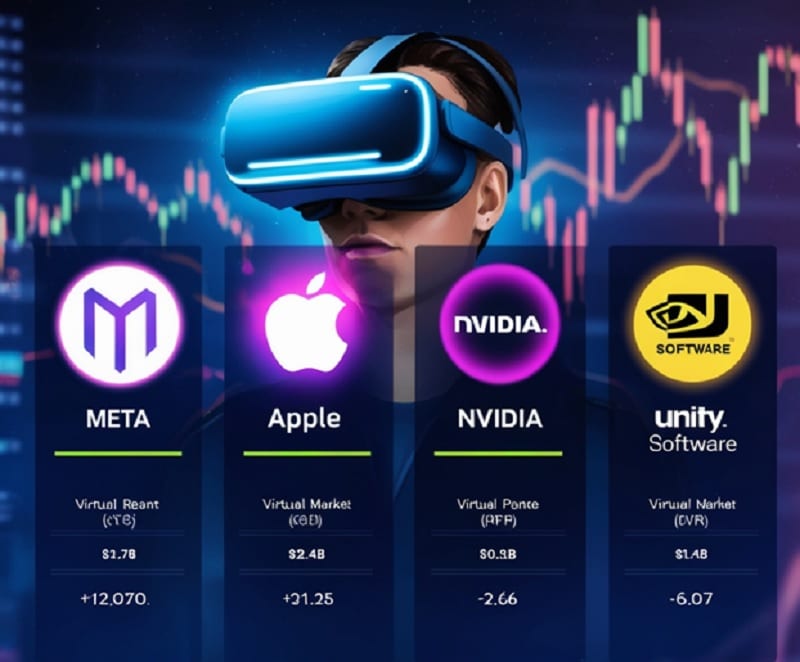Investors struggle to pick winners in VR tech. Top Virtual Reality Stocks of 2025 reveal the smartest choices for solid returns.
Virtual Reality Stocks of 2025: Overview
Virtual Reality (VR) represents one of the most promising business opportunities in 2025 for investors due to the global shift towards innovation-based sectors. The rising market demand for better VR solutions across gaming and healthcare as well as education and real estate sectors has led investors to show greater interest in this emerging technology.
Investors currently face an important challenge due to the numerous companies entering the VR market about selecting stocks with sufficient value in their investments. Making proper company selections extends beyond hype because investors must find businesses with genuine technologies and stable revenue sources besides potent long-term prospects.
This business list under the title Top Virtual Reality Stocks of 2025 provides investors with valuable information. This analysis examines five companies among numerous ones that lead both the technological development of VR and present strong financial data and promising growth trajectories.
People at all levels of tech investments can use this guide to increase their VR industry success based on proven strategies.
Why is Virtual Reality a Hot Investment in 2025?
Virtual Reality stands as a main element in building the core infrastructure for what will become a future tech revolution. VR technology will extend its reach from gaming and entertainment through 2025 because it targets the healthcare field as well as remote work services and retail education and training markets. Wide-scale industry adoption establishes the VR market as a top investment destination for this year.
📈 Explosive Market Growth
Research data shows the Virtual Reality market will surpass $100 billion by 2026 because individuals and businesses align to demand its services. Industry leaders from big tech dedicate massive investments in creating VR infrastructure and wearable technology along with content delivery systems to generate consistent stock market growth.
🌐 Real-World Applications Are Expanding
- Healthcare: VR is being used for surgical training, mental health therapies, and patient simulations.
- Corporate Training: Companies are using VR to train employees in realistic, immersive environments.
- Education: Schools and universities are incorporating VR for interactive learning experiences.
- Retail & Real Estate: Virtual showrooms and property tours are becoming the norm.
💡 Tech Giants Are All In
The innovative technology market is dominated by Apple as well as Meta and Nvidia since they develop advanced devices and software systems and build essential infrastructure. The participation of these companies strengthens the entire virtual reality market through credibility while increasing its long-term value so their stocks remain top candidates in the 2025 VR market.
Criteria for Selecting Top Virtual Reality Stocks
Investors should not put their money into every VR initiative that enters the market. Some companies focus on hype and experimentation whereas just a limited few actually construct future advancements. Our method of identifying the most promising virtual reality stocks for 2025 used clear standards which combined monetary success indicators with groundbreaking technological achievements.
✅ 1. Revenue Growth & Financial Stability
A solid financial condition acts as the base to bring excellent virtual reality concepts from concepts to real-world implementation. For our investment strategy we chose companies with increasing income and solid funding that generated profits. Numbers represent the base foundation from which all investment making decisions should derive.
The analysis determined the relative market dominance of each company in the worldwide VR industry. Are they leaders or followers? What is the nature of their value creation activities: do they develop complete ecosystems or only produce individual elements? Stocks belonging to companies which guide the advancement of VR technology (such as Meta with its Metaverse concept and Nvidia through its VR GPU development) achieved higher rankings.
✅ 3. Innovation & Product Line
Simply being present within the VR industry does not suffice because true success depends on innovative methods of operation within the sector. We analyzed companies which advance their boundaries through hardware modifications and software development along with dual innovations. Innovation stands as the essential factor when observing VR products ranging from advanced headsets to game engines which support VR technology or content delivery platforms.
✅ 4. Partnerships & Ecosystem Integration
Business partnerships between companies in strategic alliances tend to develop stronger long-term survival potential and market acceptance. Wealth from any virtual reality stock increases when the system operates at an optimal integration level with outside networks.
✅ 5. Scalability & Long-Term Vision
The stock selection focused on picking companies with modular business models combined with defined strategies for VR advancement. The enterprise value extends beyond existing headset production because companies must demonstrate their strategy for future global VR market readiness.
Top 5 Virtual Reality Stocks of 2025
As VR continues its rapid expansion investors want to identify stocks which show maximum growth potential for 2025. We conducted a rigorous assessment which led us to determine the Top Virtual Reality Stocks expected to control the market during 2025. This is the summary of major VR players and emerging disruptive companies:
⭐ 1. Meta Platforms (META)
Meta which used to be known as Facebook stands among the leading companies focusing on virtual reality technologies. As Meta continues to make its substantial investment in both the Metaverse program and the Oculus product series the company dominates contemporary VR market adoption. The company dedicates substantial resources to VR software development and hardware production to become a prominent force among Top Virtual Reality Stocks of 2025.
- Strengths:
- The Oculus Quest series represents the leader position in VR hardware devices.
- The Metaverse ecosystem receives large financial investments that will drive the adoption of VR technology.
- The company establishes alliances between different industrial sectors to uplift virtual reality adoption practices.
- Future Potential: Billions of investment dollars position Meta to lead future virtual spaces thus making its stock a potential lucrative investment.
⭐ 2. Apple Inc. (AAPL)
Apple will enter the VR/AR market after launching its forthcoming Vision Pro headset. Apple continues to build seamless device connections so its inclusion of VR technology creates market opportunities for future dominance. The Top Virtual Reality Stocks ranking must include Apple as a fundamental entry.
- Strengths:
- The company is famous for both brand dedication and premium hardware products.
- According to product announcements the planned headset from Apple provides users advanced immersive capabilities.
- Apple customers are more likely to adopt VR technology because they stay faithful to the brand and use multiple Apple devices.
- Future Potential: Apple’s ecosystem and the potential of Vision Pro position it as a strong player in the VR space, especially in AR and mixed-reality applications.
⭐ 3. Nvidia (NVDA)
The graphics processing units from Nvidia function as the fundamental hardware component which powers VR performance although the company itself does not produce VR content or equipment. Any serious VR system requires Nvidia’s RTX series to provide the leading high-end graphics solution for VR applications. Nvidia takes its position as one of the key stocks worth considering for VR investment.
- Strengths:
- The company controls the GPU market segment which allows it to enhance VR rendering abilities.
- VR experiences require the combination of electronic high-performance computing technology with artificial intelligence.
- The company maintains strong mutual relationships with both VR hardware developers along with gaming studios.
- Future Potential: The advancement of VR technology will help Nvidia expand its user base of immersive VR environment rendering and thereby strengthen its status as a leading tech stock.
⭐ 4. Unity Software (U)
The production of VR and AR content thrives at Unity Software because it functions as an industry-leading platform. Adoption of Unity among VR developers remains high because it represents one of the leading game engines for creating VR projects. VR applications need their tools for creation to operate which makes them an influential stock in the virtual reality market.
- Strengths:
- The versatile platform of this company dominates VR game development.
- The VR market will experience significant expansion because non-gaming developers build increasing applications for industry and education.
- High developer adoption and large content library.
- Future Potential: The critical importance of VR content creation for market expansion encourages investors to choose Unity for its versatility because it positions the company as a leading long-term investment in the VR sector.
⭐ 5. Sony Group Corp. (SONY)
As a leading power in virtual reality gaming Sony brings users the PlayStation VR2 along with additional VR equipment. Sony stands among the top virtual reality stock choices for 2025 based on their extensive gaming infrastructure coupled with their dedication to virtual reality development.
- Strengths:
- Strong presence in the gaming industry with PlayStation VR2.
- The company continues development of virtual reality experiences through innovation.
- PlayStation VR2 offers its own set of exclusive games that propel adoption while generating sales.
- Future Potential: Sony demonstrates strong potential to dominate virtual reality beyond entertainment because it maintains a secure gaming ecosystem combined with the expansion of non-gaming VR applications.
Comparison Table of Top Virtual Reality Stocks
For a quicker comparison and to help investors easily weigh the Top Virtual Reality Stocks of 2025, we’ve summarized the key details in the table below. This table provides an overview of each company’s strengths, focus areas, and financial outlook:
| Company | Stock Ticker | Key Strength | Focus Areas | 2025 Investment Potential |
| Meta Platforms | META | Leader in Metaverse and VR hardware | VR headsets (Oculus), Metaverse, AI-powered VR | High (Metaverse growth) |
| Apple Inc. | AAPL | Premium VR/AR ecosystem | Vision Pro headset, seamless device integration | High (AR/VR integration) |
| Nvidia | NVDA | GPU dominance for VR content | VR rendering, AI, high-performance computing | High (Critical for VR rendering) |
| Unity Software | U | Leading VR content development platform | VR gaming, industrial VR, non-gaming applications | High (Content creation growth) |
| Sony | SONY | Strong VR gaming presence | PlayStation VR, gaming & immersive entertainment | Moderate (Gaming and beyond) |
Key Insights:
- The major VR development driver comes from Meta due to its substantial Metaverse
- The upcoming Apple Vision Pro device seeks to transform VR and AR capabilities by integrating perfectly with Apple’s system environment.
- Nvidia GPUs maintain essential status in delivering high-quality VR experiences and their position will expand with rising VR market demand.
- Content creation using Unity software remains the essential driver for VR market development as it continues to control this vital aspect.
- The gaming company Sony directs its VR strategy toward entertainment products while focusing on the promising gaming industry sector.
A reference guide known as a snapshot provides investment direction to stakeholders who want to evaluate Top Virtual Reality Stocks. Three factors of hardware innovation together with content development alongside ecosystem integration position these companies as strong candidates for future growth opportunities in VR.
Risks to Consider Before Investing in Virtual Reality Stocks
Investors need to evaluate the potential risks that exist in Top Virtual Reality Stocks because this market sector shows strong growth prospects. The financial results of VR companies face potential setbacks from multiple problematic elements that stem from new technology. Several important risks should be considered in investments of Top Virtual Reality Stocks.
⚠️ 1. Technology Uncertainty
The virtual reality industry starts as an immature field. Despite great potential VR technology could develop at a slower pace than people originally anticipated. Consumer acceptance moves at a slow pace while failure of VR software and hardware to perform as expected makes it difficult for companies to become profitable.
- Risk: Slow technology adoption could lead to delayed returns on investment, especially for hardware-heavy companies like Meta and Sony.
- Solution: Keep an eye on product launches, user feedback, and how quickly companies are adapting to changing consumer preferences.
⚠️ 2. High Capital Expenditures
Extensive funding allocations in research and development (R&D) become necessary to develop both VR hardware and content versions. Meta and Apple together dedicate billions to virtual reality development while realizing their investment returns might extend over multiple years. The high investments in capital development represent a challenge because market expansion might not reach predicted levels.
- Risk: Companies may experience losses or reduced profits in the short term due to heavy spending on innovation and infrastructure.
- Solution: Consider looking at companies with solid financials or diversified portfolios that can weather these heavy investments.
⚠️ 3. Competition
The VR market presents strong competition between existing participants. Top companies Meta together with Apple and Sony operate vigorously in the VR industry yet smaller novel ventures possess the potential to reshape the market structure. The intense competition reduces market share capacity for companies that lack distinctive market positioning particularly when they fail to establish unique differentiators.
- Risk: Intense competition could lead to market fragmentation and pressure on stock prices.
- Solution: Focus on companies with a clear competitive advantage, whether it’s in hardware innovation, content development, or ecosystem integration.
⚠️ 4. Regulatory Challenges
The rising integration of VR into daily existence may trigger governmental oversight on privacy protection together with security questions as well as data protection methods. Worldwide governments might enact regulations which determine how VR firms operate particularly in aspects like user data collection and privacy protection.
- Risk: New regulations could increase costs or hinder the growth of VR companies, particularly those in social VR spaces.
- Solution: Stay updated on potential regulatory changes, especially concerning data privacy, as they could affect companies like Meta.
⚠️ 5. Consumer Hesitation
Victories in VR technological advancement have not persuaded most consumers to accept virtual reality fully. The abortion rate in the United States exhibits high costs and limited content variety and causes physical discomfort in users that together constrain widespread adoption. A wide consumer acceptance of VR remains out of reach so businesses face challenges to keep their product sales steady.
- Risk: Slow consumer adoption could delay growth and reduce the overall potential of VR stocks.
- Solution: Look for companies that are focusing on improving user experience, affordability, and content variety to address consumer hesitations.
Conclusion
The advancement of virtual reality has moved beyond futuristic speculation because it is currently transforming our relationships with technological devices and mass media platforms and expanding their applications in the physical environment. Businesses that invest their resources into VR development throughout 2025 confront more than passing fads since they actively define upcoming capabilities across workplace operations and entertainment worldwide.
The virtual reality revolution has its foundation in leading stock companies including Meta, Apple, Nvidia, Unity and Sony. These companies offer distinctive capabilities that range from hardware development to platform development and backend system capabilities which create excellent investment possibilities for investors who look ahead.
Despite vast potential it’s vital to make your investments carefully among these opportunities. Different investors should follow three rules to invest wisely: they must understand potential risks while following technology trends and checking financial documents and analyzing how rapidly consumers and industries accept VR applications. An investor will need to build diverse portfolios and exhibit long-term patience when investing.
Investing in virtual reality stocks at this time offers substantial future benefit because immersive experiences are dominating the modern world.
FAQ: Top 5 Virtual Reality Stocks of 2025
What are the Top Virtual Reality Stocks to watch in 2025?
The most promising virtual reality stocks in 2025 include Meta, Apple, Nvidia, Unity Software, and Sony. These companies are innovating in VR hardware, content, and infrastructure, making them strong investment candidates.
Are the Top Virtual Reality Stocks suitable for long-term investment?
Yes, top virtual reality stocks have long-term potential due to rapid industry growth. However, investors should consider the risks like slow adoption, high R&D costs, and competition.
How do I identify the Top Virtual Reality Stocks?
Look for companies with strong financials, consistent innovation, a large user base, and involvement in key VR sectors like gaming, healthcare, education, or enterprise solutions.
What sectors benefit most from the Top Virtual Reality Stocks?
Sectors gaining from top virtual reality stocks include gaming, healthcare, education, real estate, and manufacturing, where VR is transforming training, sales, and user experiences.
Are the Top Virtual Reality Stocks impacted by AI and AR?
Yes, many top virtual reality stocks are integrating AI and AR to enhance immersive experiences. This convergence strengthens their market position and boosts their long-term value.

































